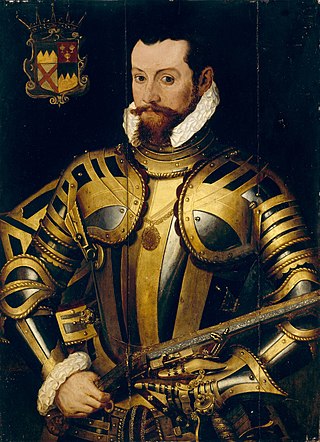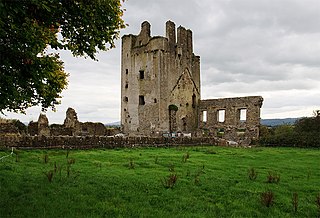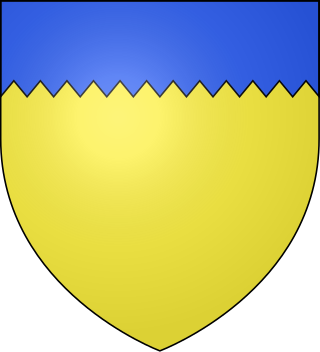Related Research Articles

Thomas Butler, 10th Earl of Ormond and 3rd Earl of OssoryPC (Ire), was an influential courtier in London at the court of Elizabeth I. He was Lord Treasurer of Ireland from 1559 to his death. He fought for the crown in the Rough Wooing, the Desmond Rebellions, and Tyrone's Rebellion. He fought his rival, Gerald FitzGerald, 14th Earl of Desmond in the Battle of Affane in 1565.
James Butler, 2nd Earl of Ormond was a noble in the Peerage of Ireland. He was Lord Justice of Ireland in 1359, 1364, and 1376, and a dominant political leader in Ireland in the 1360s and 1370s.
Sir Walter Butler, 11th Earl of Ormond and 4th Earl of Ossory (1559–1633), succeeded his uncle Black Tom, the 10th earl, in 1614. He was called "Walter of the Beads" because he was a devout Catholic, whereas his uncle had been a Protestant. King James I intervened and awarded most of the inheritance to his uncle's Protestant daughter Elizabeth. Ormond contested the King's decision and was for that insolence detained in the Fleet Prison from 1619 until 1625 when he submitted to the King's ruling. He then found a means to reunite the Ormond estate, by marrying his grandson James, who had been raised a Protestant, to Elizabeth's only daughter.
James Butler, 4th Earl of Ormond was the son of James Butler, 3rd Earl of Ormond. He was called 'The White Earl', and was esteemed for his learning. He was the patron of the Irish literary work, 'The Book of the White Earl'. His career was marked by his long and bitter feud with the Talbot family.
James Butler, 3rd Earl of Ormond, was a noble in the Peerage of Ireland. He acceded to the title in 1382, and built Gowran Castle three years later in 1385 close to the centre of Gowran, making it his usual residence, whence his common epithet, The Earl of Gowran.
James Butler, 1st Earl of Ormond, was a noble in the Peerage of Ireland. He was born in Arklow, Wicklow, Ireland and died in Gowran, Kilkenny, Ireland.

Earl of Carrick, in the barony of Iffa and Offa East, County Tipperary, is a title in the Peerage of Ireland.

Theobald Walter was the first Chief Butler of Ireland. He also held the office of Chief Butler of England and was the High Sheriff of Lancashire for 1194. Theobald was the first to use the surname Butler of the Butler family of Ireland. He was involved in the Irish campaigns of King Henry II of England and John of England. His eldest brother Hubert Walter became the Archbishop of Canterbury and justiciar and Lord Chancellor of England.
Joan Butler, Countess of Carrick was an Irish noblewoman, and the wife of Edmund Butler, Earl of Carrick, Justiciar of Ireland. She was the mother of James Butler, 1st Earl of Ormond.
Sir Edmund MacRichard Butler of Polestown was the eldest son of Sir Richard Butler of Polestown and adopted the Gaelic title of The MacRichard of Ossory.
Sir James Butler of Polestown was a warlord in Yorkist Ireland.

Sir Edmund Butler of Cloughgrenan, was an Irish noble and the second son of James Butler, 9th Earl of Ormond and Lady Joan Fitzgerald. He was a scion of the House of Ormond, and a rebel against the Tudors.
Theobald Butler, 4th Chief Butler of Ireland was the son of Theobald Butler, 3rd Chief Butler of Ireland and Margery de Burgh, daughter of Richard Mor de Burgh, 1st Lord of Connacht. He assisted King Edward I of England in his wars in Scotland. He died at the castle of Arklow, County Wicklow, Ireland, and was buried at Arklow Monastery.
Iffa and Offa East is a barony in County Tipperary, Ireland. This geographical unit of land is one of 12 baronies in County Tipperary. Its chief town is Clonmel. The barony lies between Iffa and Offa West to the west, Middle Third to the north-west and Slievardagh to the north-east. It is currently administered by Tipperary County Council. The entire barony lies within the geographic remit of the Roman Catholic Diocese of Waterford and Lismore with the exception of the parish of Clerihan which is in the Roman Catholic Archdiocese of Cashel and Emly.

John Butler of Kilcash was an Irish landowner and soldier. A younger son of James Butler, 9th Earl of Ormond and brother of Thomas Butler, 10th Earl of Ormond, he received Kilcash Castle as appanage. He fought in the Desmond–Ormond conflict and was badly wounded in 1563, just before the Battle of Affane. He was the start-point of the Kilcash branch of the Ormonds and the father of Walter Butler, 11th Earl of Ormond.
Thomas Butler, Viscount Thurles was the son and heir apparent of Walter Butler, 11th Earl of Ormond (1559–1633), whom he predeceased. He lived at the Westgate Castle in Thurles, County Tipperary. He was accused of treason but drowned in a shipwreck off the Skerries in the Irish Sea, before he could be judged. He was the father of the Irish statesman and Royalist commander James Butler, 1st Duke of Ormonde.

Butler is the name of a noble family whose members were, for several centuries, prominent in the administration of the Lordship of Ireland and the Kingdom of Ireland. They rose to their highest prominence as Dukes of Ormonde. The family has produced multiple titles such as Baron Cahir, Baron Dunboyne, Viscount Ikerrin, Viscount Galmoye, Viscount Mountgarret, Viscount Thurles, Earl of Carrick, Earl of Kilkenny, Earl of Ormond, Earl of Ossory, Marquess of Ormonde and Duke of Ormonde. Variant spellings of the name include le Boteler and le Botiller. The Butlers were descendants of Anglo-Norman lords who participated in the Norman invasion of Ireland in the 12th century. The surname has its origins in the hereditary office of "Butler (cup-bearer) of Ireland", originating with Theobald Walter, 1st Chief Butler of Ireland. The arms of later family members depicted three cups in recognition of their original office.
Peter Butler of Roscrea, County Tipperary, was a descendant of the Butler family - the Earls of Ormond. He was the second son of Edmond Butler of Polestown. The "Roscrea" cadet branch of the family is in turn descended from the "Polestown" cadet branch.
John Butler of Clonamicklon, was born in Arklow, Wicklow, Ireland the youngest son of Edmund Butler, Earl of Carrick and Joan FitzGerald. Once older he moved north from Lismalin and established a junior branch of the family in the Slieveardagh Hills at Clonamicklon, County Tipperary.

Elizabeth Poyntz (1587–1673), known as Lady Thurles, was the mother of the Irish statesman and Royalist commander James Butler, 1st Duke of Ormonde.
References
- 1 2 3 4 5 6 7 8 9 10 11 12 13 14 Robin Frame (3 January 2008). "Butler, Edmund, earl of Carrick (d. 1321)" . Oxford Dictionary of National Biography (online ed.). Oxford University Press. doi:10.1093/ref:odnb/50020 . Retrieved 28 September 2022.(Subscription or UK public library membership required.)
- 1 2 3 4 5 6 7 8 9 10 The Complete Peerage, vol. II Bass to Canning, pp. 449–450, retrieved 28 September 2022
- ↑ Lodge, John, The Peerage of Ireland or, A Genealogical History Of The Present Nobility Of That Kingdom, 1789, Vol IV, p 6.
- ↑ O'Mahony, Charles (1912). The Viceroys of Ireland. p. 25.
- ↑ "Edmund was granted a charter of the castle and manor of Karryk Macgryffin and Roscrea to hold to him and his heirs sub nomine et honore comitis de Karryk. The patent was dated at Lincoln 1 September that year, 1315; on that date, he was given the return of all the King's writs in the cantreds of Oreman (sic) (Ormond), Elyogerth (sic) (Eliogarty) which are today located in County Tipperary, and also the cantred of Elyocarroll (now the baronies of Clonlisk and Ballybritt in County Offaly). To these was added, on 12 November 1320, all the lands of William de Carran in Finagh and Favmolin in County Waterford." Lodge, John The Peerage of Ireland or, A Genealogical History Of The Present Nobility Of That Kingdom, 1789, Vol IV, p 7.
- ↑ Lodge, John, The Peerage of Ireland or, A Genealogical History Of The Present Nobility Of That Kingdom, 1789, Vol II, pg 313.
- ↑ Lodge, John The Peerage of Ireland or, A Genealogical History Of The Present Nobility Of That Kingdom, 1789, Vol IV, p 7.